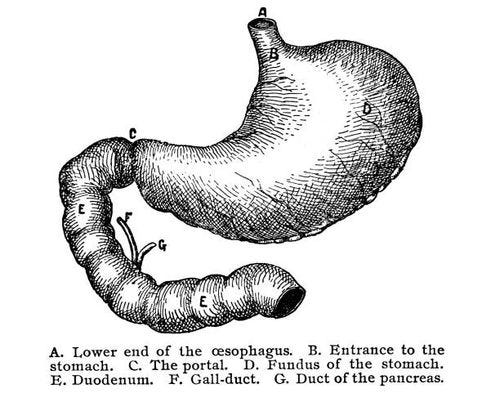CQRG's Winter Medical Terminology Boot Camp
DAY 10 / INTRODUCTION TO THE DIGESTIVE & ENDOCRINE SYSTEMS
Welcome to Day 10!
If you are new to our programs we invite you to click on the PROGRAMS tab above to check them. This short program ends today. But, don’t worry! Each lesson is designed to be a standalone experience, so you can catch up later. Subscribe to receive reference guides emailed to you, or follow along in the Notes section.
Introduction to the Digestive System
digestive (adj).
meaning: of, or pertaining to digestion
The word "digestive" originated in the early 15th century and was initially used to describe something related to the process of digestion in the body.
Origins of the term relate to the Old French "digestif" and the Late Latin "digestivus," both of which are derived from the Latin word "digerere." This Latin word means "to separate, divide, arrange," and its literal translation is "to carry apart." It is formed by combining the prefix "dis-" meaning "apart" and the verb "gerere" meaning "to carry."
In earlier English usage, "digestive" was also used as a noun to refer to a preparation or medicine that aids digestion.
The gastrointestinal system consists of the gastrointestinal tract, also known as the GI tract or digestive tract, along with the liver, pancreas, and gallbladder.
This tract is a sequence of hollow organs interconnected in a lengthy, winding tube extending from the mouth to the anus. The hollow organs comprising the GI tract include the mouth, esophagus, stomach, small intestine, large intestine, and anus. On the other hand, the liver, pancreas, and gallbladder are the solid organs within the digestive system.
Key Functions Of The Digestive System
Every component in the gastrointestinal system plays a role in facilitating the movement of food and liquids along the digestive tract, breaking them down into smaller components, or performing both functions simultaneously. Food moves through the tract by a process called peristalsis.
Key term: peristalsis
involuntary muscle movement that occurs in the digestive system;
these wave-like muscle contractions move food through the digestive tract
Major Features of the Digestive System
Mouth
Epiglottis, a small flap of tissue, folds over the “windpipe” to prevent choking and allows food to pass into the esophagus.
Once swallowing begins, the process becomes automatic as the brain signals the muscles of the esophagus and peristalsis begins.
At the end of the esophagus, the lower esophageal sphincter relaxes to allow food to enter the stomach.
This sphincter typically remains closed to prevent stomach contents from flowing back into the esophagus.
In the stomach, food and liquid are mixed with digestive juices by the stomach muscles.
The stomach then gradually empties its contents, known as chyme, into the small intestine.
Within the small intestine, food is mixed with digestive juices from the pancreas, liver, and intestine.
This mixture is moved along for further digestion, and the walls of the small intestine absorb water and nutrients into the bloodstream.
Waste products move into the large intestine as peristalsis continues.
The large intestine absorbs water and transforms waste into stool, including undigested food parts, fluid, and older cells from the GI tract lining.
Peristalsis aids in moving the stool into the rectum.
These features along with hormones and nerves collaborate to regulate the digestive process. Signals move freely back and forth between the gastrointestinal tract and the brain. The body will use the sugars, amino acids, fatty acids, and glycerol it receives to build substances needed for energy, growth, and cell repair.
Introduction to the Endocrine System
Endocrine system hormones play a crucial role in the regulation of essential body functions.
The endocrine system consists of glands and organs that produce hormones and secrete them into the bloodstream, allowing them to reach various tissues and organs throughout the body. These hormones are key to the regulation of human growth, metabolism, and reproduction.
Key term: endocrine
pertaining to internal secretion;
function to regulate internal mechanisms
Major Functions of the Endocrine System
The endocrine system is a sophisticated communication network.
The endocrine system is a powerful communication system. It uses hormones to regulate the activities of various organs through the circulatory system. In humans, the hypothalamus serves as the central control center for endocrine activities. It secretes hormones that stimulate or suppress the release of hormones in the pituitary gland, in addition to controlling appetite, blood pressure, sleep, temperature, and water balance.
Key term: hormone
type of chemical “messenger;”
function to regulate internal mechanisms
Key term: hypothalamus
gland located in the brain;
regulates endocrine system
Key term: pituitary gland
also known as the hypophysis;
produces hormones that control many processes in the body
The pituitary gland is a small gland located underneath the brain. It has two main lobes, the anterior pituitary gland and the posterior pituitary gland (joined by the pars intermedia). The pituitary is attached to the hypothalamus, which controls its activity.
Major Endocrine System Components
Hypothalamus - secretes hormones that stimulate or suppress the release of hormones in the pituitary gland, in addition to controlling water balance, sleep, temperature, appetite, and blood pressure.
Pineal body - produces the hormone melatonin.
Pituitary - gland controls many functions of the other glands.
Thyroid and parathyroid - the thyroid plays an important role in metabolism. The parathyroid glands regulate the body's calcium balance.
Thymus - factor in the production of white blood cells to fight infection.
Adrenal gland - makes and releases corticosteroid hormones and epinephrine to maintain the blood pressure and regulate metabolism.
Pancreas - aids in digestion, as well as hormone production. Hormones including insulin and glucagon, regulate blood sugar levels.
Ovaries - produces estrogen and progesterone.
Testes - produce testosterone.
Helpful Video:
endocrine (adj.)
from Latinized Greek terms;
“Endocrine” as a medical term arises from “endon,” referring to “within” and “krinein” meaning “to separate, or distinguish.”
The pancreas functions as an organ of both the digestive and endocrine systems. In humans, the pancreas is located in the abdomen behind the stomach.
Helpful Video:
Recommended Reading (Optional)
Textbook
Medical Terminology for Healthcare Professions, Katherine Greene and Andrea Nelson
Read Chapters 13 & 14










